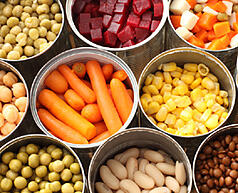Part 3: Controlling Inventory Levels
The first step in computing what item to order and how much you need is to determine the inventory level, or the amount needed on hand at all times. This is a simple procedure, but it requires order sheets. To determine the amount you need to order, you must first know the amount you have in inventory. Walk through the storage areas and mark in the "On Hand" column the amounts that are there. To determine the "Build to Amount," you will need to know when regularly scheduled deliveries arrive for that item and the amount used in the period between deliveries. Add on about 15 percent to the average amount used; this will cover unexpected usage, a late delivery or a backorder from the vendor. The amount you need to order is the difference between the "Build to Amount" and the amount "On Hand." Experience and food demand will reveal the amount an average order should contain. By purchasing too little, the restaurant may run out of supplies before the next delivery. Ordering too much will result in tying up money and putting a drain on the restaurant's cash flow. Buying up items in large amounts can save money, but you must consider the cash-flow costs.
- A buying schedule should be set up and adhered to. This would consist of a calendar showing:
-Which day's orders need to be placed.
-When deliveries will be arriving.
-What items will be arriving from which company.
-Phone numbers of sales representatives to contact for each company.
-The price the sales representative quoted.
- Post the buying schedule on the office wall. When a delivery doesn't arrive as scheduled, the buyer should place a phone call to the salesperson or company immediately. Don't wait until the end of the day when offices are closed.
- A Want Sheet may be placed on a clipboard in the kitchen. This sheet is made available for employees to write in any items they may need to do their jobs more efficiently. This is a very effective form of com munication; employees should be encouraged to use it. The buyer should consult this sheet every day. A request might be as simple as a commercial-grade carrot peeler. If, for example, the last one broke and the preparation staff has been using the back of a knife instead, the small investment could save you from an increase in labor and food costs.
This article is an excerpt from the Food Service Professional Guide to Controlling Restaurant & Food Service Food Costs, authored by Douglas R. Brown, published by Atlantic Publishing Company. This excerpt has been reprinted with permission of the publisher. To purchase this book go to:


